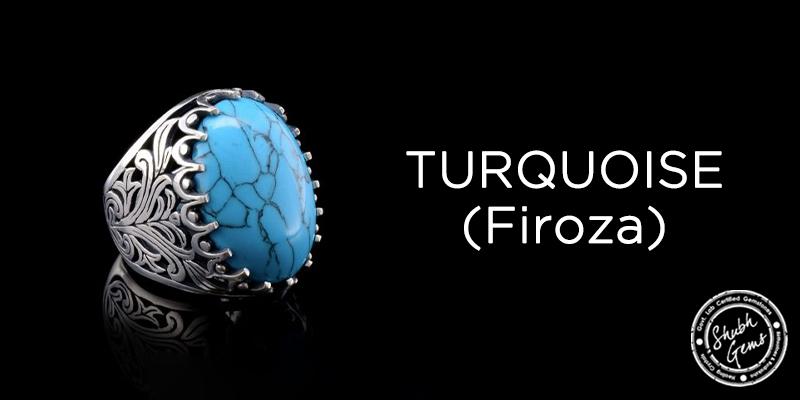Turquoise (Firoza): History and Significance

Turquoise (Firoza) is an opaque, blue-to-green mineral. The colour of Turquoise may vary from bluish-white to sky blue and from greenish-blue to lemon green. It is one of the first gemstones to ever be mined. It dates back to 6000 BC in the Sinai Peninsula of Egypt.
It has been prized as a gemstone and ornamental stone for years due to its multi-layered history and unique hue. Apart from its unmatched charm, it provides the wearer with a lot of astrological benefits as well.
Turquoise represents wisdom, tranquility, protection, good fortune and hope. It is regarded as sacred stone in the Buddhist community. It is the traditional gemstone for the people born in the month of December.
History and Ancient Beliefs
Turquoise is one of the world’s most ancient gems known to the human civilisation. Archaeological excavations revealed that the rulers of ancient Egypt adorned themselves with Turquoise jewellery and Chinese artisans were carving it more than 3,000 years ago.
A stone worn and used by pharaohs, ancient warriors and multiple tribes, Turquoise has many stories associated with it. In many cultures of the Old and New Worlds, this gemstone has been esteemed as a holy stone, a bringer of good fortune and a talisman.
The ancient Egyptians associated Turquoise with the goddess, Hathor. Their use of Turquoise stretches back as far as the first dynasty (possibly earlier). The most well-known pieces incorporating the gem are those recovered from Tutankhamun's tomb, most notably the Pharaoh's iconic burial mask which was liberally inlaid with the stone.
Early Native American tribes believed in the protection powers of this beautiful blue stone. They associated it with the god of the sky, and shamans relied on the stone as a conduit between heaven and Earth. The Aztecs tribe inlaid Turquoise into provocative mosaic objects such as masks, knives, and shields. The Pueblo tribe are believed to have prospered greatly from their production and trading of Turquoise objects. The Apache tribe used to embellish their bows with Turquoise believing that the powerful stone improved aim and accuracy.
The ancient jewelled works of art from Turkey and Persia showcase their love for this beautiful gemstone. Turkish warriors crafted talismans from the ancient mineral. They believed these amulets protected them specifically from injuries. In ancient Persia, the sky-blue gemstone were worn round the neck or wrist as protection against unnatural death. Turquoise was also often engraved with devotional words in Arabic script which was then inlaid with gold. Furthermore, the stone was extensively used to decorate objects and important buildings both inside and out, such as the Medresseh-i Shah Husein Mosque of Isfahan.
In India, Turquoise became popular during the Mughal Empire and its influence can be seen in buildings such as the Taj Mahal. In Greece, maidens wore the sea-green stone as a symbol of their purity. In England, maidens offered gifts of Turquoise to their lovers as a symbol of their enduring love. In Russia, the blue-green stones were often incorporated by couples into their wedding rings.
In contemporary western use, Turquoise is most often encountered in silver rings or bracelets and as tumbled or roughly hewn beads in chunky necklaces. In India, Turquoise has gained an unprecedented popularity because of the Bollywood actor Salman Khan, who wears a 50 carat Turquoise in a silver bracelet on his wrist.
Benefits of Turquoise (Firoza)
Since ancient times, Turquoise gemstone has been considered a pure and sacred stone that brings positivity, happiness, luck, wealth and good health to its wearer. It is a stone that weaves more life affirming fortune into your world.
- Turquoise is especially beneficial for people who work in fields like films, fashion, television, jewellery, accountancy, law, education and clothing.
- It benefits the wearer by improving their decision-making skills, increasing their focus and enhancing their thinking ability.
- According to Vedic astrology, wearing this blue stone positively affects the wearer’s social status and lifestyle.
- Turquoise is an excellent healing stone. Its healing energy is all about serenity and peace. It has a calming energy that makes it a great stone for when you are feeling overwhelmed. It is a great remedy for mood swings, anxiety, and panic attacks.
- It has a strong connection to the throat chakra, and helps to enhance communication and expression. It also helps to align all of the chakras.
- Turquoise acts as a protective shield for the wearer. It is a perfect companion for those who travel a lot as it protects them from thefts, accidents, or any unwanted incidences.
- Turquoise ensures overall physical fitness. It enhances immunity and eliminates pollution inflicted diseases. It also leads to tissue revival and body strengthening for a healthier body and soul.
- Turquoise is known to aid in spiritual transformation no matter which stage of your journey you find yourself at. It is said to connect heaven and earth, and help us connect to the spiritual world.
Evaluating a Turquoise Stone
The robin’s egg blue (sky blue colour) Persian Turquoise mined near the modern city of Neyshabur in Iran has been used as a guiding reference for evaluating Turquoise quality. The price of the stone depends on its origin, colour, surface texture and shape.
Origin:
Turquoise is found in only a few places on earth. The major sources of Turquoise are Iran (Persia), Tibet, Mexico and Arizona. Persian Turquoise from Nishapur district of Iran is most sought after due to its bright blue hue, high clarity and matt to waxy luster. Stones from Tibet & China usually have spider web pattern on the surface and are primarily used in fashion jewellery.
Color:
The colour of Turquoise ranges from a powder blue to a sky blue to a bluish-green to a yellowish green. The most-prized Turquoise color is an even, intense, medium blue, sometimes referred to as robin’s egg blue or sky blue in the trade. The vivid blue coloured Turquoise from Arizona mines is also desirable in trade. Turquoise with a green to greenish blue colour is less desirable but it depends on personal preference. There are some contemporary designers who actively seek avocado and lime green Turquoise.
Surface Texture:
Turquoise is an opaque stone. Its clarity is judged by its surface texture and finish. The lustre of turquoise is typically waxy to sub vitreous. In Turquoise, low porosity and fine texture are more valuable than high porosity and coarse texture. Natural turquoise can have significantly visible matrix and patterns like spider web. Clean and spotless Turquoise is very precious and most suitable for astrological purpose. But some buyers prefer the presence of matrix in fashioned Turquoise if its effect is attractive and balanced.
Shape:
Turquoise is often cut as Cabochon in various shapes as the smoothly rounded dome shape sets off turquoise’s color, texture, and any matrix beautifully.
Shubh Gems has a team of Gemstone / Healing Experts who guide you to choose the most suitable Gemstone based on your Birth-chart in Vedic Astrology. Have Query ?






























































comments